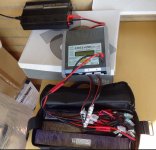ElectricGod
10 MW
Ohbse said:I have purchased from and have had others also order with good success from "Shenzhen E-fire Technology Development Co.,LTD" http://www.cl-rd.cn/
Friendly, flexible, good pricing. I would recommend asking for pricing from a couple of different reputable Alibaba suppliers. Key to success with ordering cells from China is the supplier getting the packaging right, if you get a quote for shipping dramatically lower than competitors I would be asking why. I've heard all sorts of horror stories of batteries being seized by customs due to deliberate mislabeling etc. Ms Little Bear (that's really her name) from Shenzhen E-fire was excellent and all the cells I have ordered were packaged individually and to the letter of the law regarding lithium shipping.
Thanks for the info on the seller. I have contacted them. I know what you mean about lithium batteries not getting shipped correctly. The LIPOs I bought a while back came out of China and they shipped the first batch OK, but everything after that was envelopes and randomness.
How many extras do you think I should get? I never expect 100% success. I'll put all the cells through some basic tests to make sure they are OK, but that's to cull the weak ones that show up right away. That's what I want the extra cells for.







